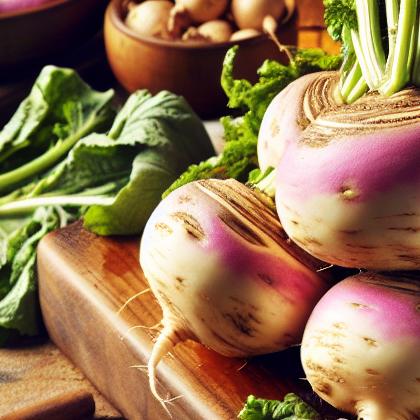Showing results for 'Turnips'
close
Turnips

For similar vegetables also called "turnip", see Turnip (disambiguation).The turnip or white turnip (Brassica rapa subsp. rapa) is a root vegetable commonly grown in temperate climates worldwide for its white, bulbous taproot. Small, tender varieties are grown for human consumption, while larger varieties are grown as feed for livestock. In the north of England and Scotland, turnip (or neep; the word turnip itself is an old compound of neep) refers to the larger, yellow rutabaga root vegetable which is also known as the "swede" (from "Swedish turnip").
Turnips Pairs With:
Food Item
Flavor Affinity Level

Did you know there are 140 food flavor pairings in my database for Turnips available. What you are seeing above is a random list of 30 items which pair with Turnips.
For the entire list, beautifully formatted, enter your email address and click the download button below, then I'll email it to you as a PDF.
Turnips Properties:
| Food Property | Type | Description |
|---|---|---|
| Flavor Profile | Sweet | Turnips have a slightly sweet flavor when roasted or cooked. |
| Bitter | Turnips can have a slightly bitter taste if eaten raw. | |
| Texture | Firmness | Turnips are firm and crunchy when raw, but become softer when cooked. |
| Nutritional Value | Fiber | Turnips are a good source of dietary fiber. |
| Micronutrients | Turnips are high in vitamin C, potassium, and folate. | |
| Color | Natural Pigments | Turnips have a white flesh with purple skin. |
| Aroma | Volatile Compounds | Turnips have a mild aroma when raw, but develop a sweeter smell when cooked. |
| Chemical Composition | Water Activity (aw) | Turnips have a high water content, giving them a crunchy texture. |
| Cooking Behavior | Heat Conductivity | Turnips cook quickly and evenly due to their high water content. |
| Water Retention | Turnips retain moisture well when cooked, resulting in a tender texture. |
Food Pairing App - Version 1.2.0
